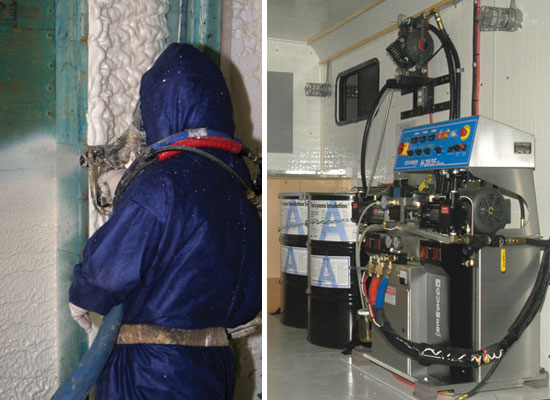Continuous Insulation Systems for Exterior Walls
Within the industry, there are two common types of spray foam insulation that are in use today. We will look at each one in detail.
Low-Density Open Cell Insulation
With a common density of about 1/2 pound per cubic foot, open cell spray foam insulation is relatively light in weight and comes with an R-value of approximately 3.5 to 3.7 per inch. It is suitable for use in cavity wall installations covered by sheathing on both sides.
 |
Spray foam insulation is mixed on site and applied using spray gun equipment appropriate to a particular manufacturer. Photos courtesy of ICYNENE, Inc. |
Low-density open cell spray foam has a comparatively softer make-up which means that it will effectively air seal around the edges and perimeter of stud cavities and any penetrations. It also means that it can flex and adjust to continue to provide an effective air seal even as the building may settle, expand, or contract. However, while open cell insulation is an effective air sealant, it does allow water vapor to permeate through it. Hence, in cold climates a warm side vapor retarder (e.g., vapor retardant paint) will be needed to control vapor diffusion in an exterior wall assembly. Some approved vapor retarders can be painted directly onto the insulation. There is, however, a wider range of vapor retarder coatings available for painting on the sheathing or gypsum board which the open cell insulation is applied against. And in cases where the wall assembly is exposed to water penetration, open cell insulation may reject bulk water depending on the specific brand. This point should be verified with the specific product manufacturer since this trait varies between products.
Some of the other benefits of open cell insulation are tied to its lighter, softer, and more flexible make-up. Acoustic control, for example, is enhanced in wall assemblies due to its absorptive properties, more so than with rigid insulation. Should water infiltrate the assembly for any reason, its vapor permeability means that the material can dry both toward the interior and the exterior as may be preferred. As a material it does not provide a food source for mold meaning it won't grow in the insulation in a wall assembly. Finally, the cost of open cell spray foam insulation is generally very attractive and competitive when compared to labor and materials for other types of insulations.
 |
Low-density open cell spray foam insulation has been installed to fill and seal stud cavities of this prefabricated wall panel and shipped to the site for final installation. Photo courtesy of ICYNENE, Inc. |
Medium-Density Closed Cell Insulation
As the name implies, medium-density spray foam insulation is heavier than low-density spray foam, coming in at about 2 pounds per cubic foot, or roughly four times heavier than low-density material. Its other defining characteristic is the closed cell nature of the insulation when mixed. Since it becomes a series of small bubbles (cells) of trapped insulating gas (a blowing agent), the thermal performance is directly enhanced, resulting in an over 70 percent increase in R-value compared to open cell insulation. R-values are possible up to R-6.9 per inch for closed cell spray foam compared to 3.7 per inch for open cell. The closed cell make-up of this insulation also means that it serves as a full air barrier eliminating the need for a separate product to perform that function. In fact, according to the Air Barrier Association of America (ABAA), many medium-density spray foam insulation are classified as air barrier materials and are the key component in tested air barrier assemblies. And in terms of vapor permeance it tests as a class II vapor retarder meaning it has very low permeance, much more so than open cell low-density spray foam.
 |
Medium-density closed cell insulation can be spray applied to the outside of the sheathing on a stud cavity wall assembly and remain durable and water resistant during the construction period. Photo courtesy of ICYNENE, Inc. |
Because of the variety of desirable physical properties in medium-density closed cell insulation, it is suitable for a variety of locations in wall assemblies. When used in stud wall cavities, it will provide higher R-values, excellent air sealing, and add some rigidity to the framing by virtue of its denser make-up. And because it already qualifies as a vapor retarder, no additional paint, membrane, or other material is needed beyond this insulation. Closed cell spray foam insulation is also rigid and durable enough to be installed outside of a stud cavity such as between masonry wythes or behind a masonry veneer. This means that the insulation can be spray applied continuously without interruptions by studs or other building components. This is quite significant since energy codes and standards such as ASHRAE 90.1 have recognized the performance boost achieved from continuous insulation (ci) in wall assemblies.
In terms of wall and façade design, closed cell insulation has the benefit of achieving higher R-values in thinner wall assemblies. From a construction standpoint, the combination of thermal, air barrier, and vapor retarding characteristics means that one product provides all three of these functions. That helps control material and labor costs. High-density foam also provides a stronger, more impact-resistant, rigid insulation material in cases where those are desired characteristics. Because of its cell structure it is water resistant and is approved by FEMA as a flood-resistant material. And, like open cell insulation, closed cell insulation is not a food source for mold to grow on the foam, even in the presence of water or vapor.









